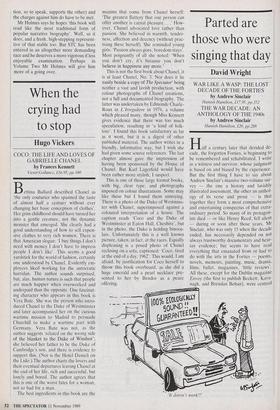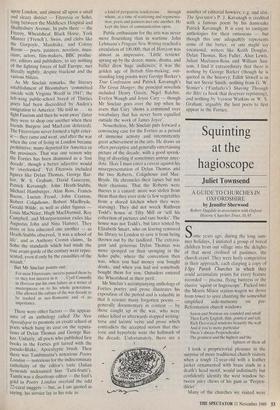Parted are those who were singing that day
David Wright
WAR LIKE A WASP: THE LOST DECADE OF THE FORTIES by Andrew Sinclair
Hamish Hamilton, £17.95, pp.352
THE WAR DECADE: AN ANTHOLOGY OF THE 1940s by Andrew Sinclair
Hamish Hamilton, £20, pp.288
alf a century later that derided de- cade, the forgotten Forties, is beginning to be remembered and rehabilitated. I write as a witness and survivor, whose judgment is based on and biased by the experience. But the first thing I have to say about Andrew Sinclair's massive two-volume sur- vey — the one a history and lavishly illustrated assessment, the other an anthol- ogy of its verse and prose — is that together they form a most comprehensive and entertaining conspectus of that extra- ordinary period. So many of its protagon- ists died — or like Henry Reed, fell silent — during or soon after those years. Mr Sinclair, who was only 15 when the decade ended, has necessarily depended on not always trustworthy documentary and hear- say evidence; but seems to have read everything that emanated from or had to
do with the arts in the Forties poems, novels, memoirs, painting, music, drama, films, ballet, magazines, 'little reviews'. All these, except for the Dublin magazine Envoy (the first to publish Beckett, Kava- nagh, and Brendan Behan), were centred
H
upon London, and almost all upon a small and sleazy district — Fitzrovia or Soho, lying between the Middlesex Hospital and Shaftesbury Avenue. In pubs there — the Fitzroy, Wheatsheaf, Black Horse, York Minster ('French'), Swiss, and clubs like the Gargoyle, Mandrake, and Colony Room — poets, painters, novelists, musi- cians, actors, film-makers, BBC produc- ers, editors and publishers, to say nothing of the fighting forces of half Europe, met literally nightly, despite blackout and the various blitzes.
As Mr Sinclair remarks, the literary establishment of Bloomsbury 'committed suicide with Virginia Woolf in 1941'; the left-wing public-school breed of Thirties poets had been discredited by Auden's emigration to America: 'He told us . . . to fight Fascism and then he went away' (later they were to shop one another when their friends Burgess and MacLean defected). The Fitzrovians never formed a tight coter- ie — they came and went, and after the war when the cost of living in London became prohibitive, many departed for America or the provinces. That was one reason why the Forties has been dismissed as a 'lost decade', though a better adjective would be 'overlooked'. Yet Fitzrovia included figures like Dylan Thomas, George Bar- ker, W. S. Graham, David Gascoyne, Patrick Kavanagh, John Heath-Stubbs, Michael Hamburger, Alan Ross, Francis Bacon, Lucian Freud, John Craxton, Robert Colquhoun, Robert MacBryde, Gerald Wilde, as well as elder figures — Louis MacNeice, Hugh MacDiarmid, Roy Campbell, and Montparnassian exiles like Augustus John and Nina Hamnet. They more or less educated one another — as heath-Stubbs observed, 'it was a school of life', and as Anthony Cronin claims, 'In Soho the standards which had made the true avant-garde of the century were repre- sented, even if only by the casualties of the assault.'
But Mr Sinclair points out:
For most Fitzrovians, success passed them by or they lost interest in it . . . Cyril Connolly in Horizon put his own failure as a writer of masterpieces on to his whole generation. This allowed the culture of the war decade to be trashed as nco-Romantic and of no importance.
There Were other factors — the appear- ance of an anthology called The New Apocalypse to promote an ersatz school of poets which hung its coat on the reputa- tions of Dylan Thomas and George Bar- ker. Unfairly, all poets who published first books in the Forties got tarred with the pseudo-Blake, Apocalyptic brush. Then there was Tambimuttu's notorious Poetry London — notorious for the indiscriminate catholicity of the editor's taste (Julian Symonds nicknamed him 'Tutti-frutti'). Tambi was a disastrous editor — the fool's gold in Poetry London overlaid the odd 22-carat nuggets — hut, as I am quoted as saying, his service lay in his role as
a kind of peripatetic rendezvous . . . through whom, at a time of scattering and regimenta- tion, poets and painters met one another. He kept the lines of communication open.
Public enthusiasm for the arts was never more flourishing than in wartime. John Lehmann's Penguin New Writing reached 'a circulation of 100,000; that of Horizon was almost as impressive. 'Little reviews' sprang up by the dozen; music, drama, and ballet drew huge audiences; it was the golden age of British film-making; out- standing long poems were George Barker's True Confession and Patrick Kavanagh's The Great Hunger; the principal novelists included Henry Green, Nigel Balchin, Evelyn Waugh and Joyce Cary — though Mr Sinclair goes over the top when he avers that Cary 'shows a command over vocabulary that has never been equalled outside the work of James Joyce'.
Nonetheless, Mr Sinclair puts forward a convincing case for the Forties as a period of immense activity and intermittently great achievement in the arts. He draws an often perceptive and generally entertaining picture of the decade, with a good sprink- ling of diverting if sometimes untrue anec- dote. Here I must enter a caveat against his misrepresentation of Dylan Thomas and the two Roberts, Colquhoun and Mac- Bryde. He chronicles their lapses but not their charisma. That the Roberts were thieves is a canard: more was stolen from them than they ever stole (a few vegetables from a shared kitchen when they were starving). They did not wreck Ruthven Todd's house at Tilty Mill or `sell his collection of pictures and rare books'. The house was not Todd's, but later rented by Elizabeth Smart, who on leaving removed his library to London to save it from being thrown out by the landlord. The extrava- gant and generous Dylan Thomas was more sponged on than sponging in the Soho pubs, where the convention then was, when you had money you bought drinks, and when you had not somebody bought them for you. Outsiders entered the Wheatsheaf at their peril.
Mr Sinclair's accompanying anthology of Forties poetry and prose illustrates his exposition of the period and is valuable in that it rescues many forgotten poems generally documentary in content — by those caught up in the war, who were either killed or afterwards stopped writing: terse and laconic verse and prose which contradicts the accepted notion that rhe- toric and hyperbole were the hallmark of the decade. Unfortunately, there are a
number of editorial howlers: e.g. and alas, The Spectator's P. J. KaVanagh is credited with a famous poem is hiS namesake Patrick Kavanagh. It is easy 40 castigate anthologies for their omissions — but though this one adequately represents some of the better, or one might say vocational, writers like Keith Douglas, Dylan Thomas, Roy Fuller, Alun Lewis, Julian Maclaren-Ross and William San- som, I find it extraordinary that there is nothing by George Barker (though he is quoted in the history); Edith Sitwell is in but not Stevie Smith; nothing from G. W. Stonier's ('Fanfarlo's') Shaving Through the Blitz (a hook that deserves reprinting), and nothing by Vernon Watkins or W. S. Graham, arguably the best poets to first appear in the Forties.











































































 Previous page
Previous page